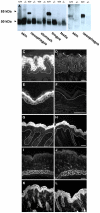Epidermal transglutaminase (TGase 3) is required for proper hair development, but not the formation of the epidermal barrier
- PMID: 22496784
- PMCID: PMC3319564
- DOI: 10.1371/journal.pone.0034252
Epidermal transglutaminase (TGase 3) is required for proper hair development, but not the formation of the epidermal barrier
Abstract
Transglutaminases (TGase), a family of cross-linking enzymes present in most cell types, are important in events as diverse as cell-signaling and matrix stabilization. Transglutaminase 1 is crucial in developing the epidermal barrier, however the skin also contains other family members, in particular TGase 3. This isoform is highly expressed in the cornified layer, where it is believed to stabilize the epidermis and its reduction is implicated in psoriasis. To understand the importance of TGase 3 in vivo we have generated and analyzed mice lacking this protein. Surprisingly, these animals display no obvious defect in skin development, no overt changes in barrier function or ability to heal wounds. In contrast, hair lacking TGase 3 is thinner, has major alterations in the cuticle cells and hair protein cross-linking is markedly decreased. Apparently, while TGase 3 is of unique functional importance in hair, in the epidermis loss of TGase 3 can be compensated for by other family members.
Conflict of interest statement
Figures









Similar articles
-
Identification of a preferred substrate peptide for transglutaminase 3 and detection of in situ activity in skin and hair follicles.FEBS J. 2010 Sep;277(17):3564-74. doi: 10.1111/j.1742-4658.2010.07765.x. FEBS J. 2010. PMID: 20716179
-
Analysis of epidermal-type transglutaminase (transglutaminase 3) in human stratified epithelia and cultured keratinocytes using monoclonal antibodies.J Dermatol Sci. 2003 Aug;32(2):95-103. doi: 10.1016/s0923-1811(03)00091-4. J Dermatol Sci. 2003. PMID: 12850301
-
Development of ichthyosiform skin compensates for defective permeability barrier function in mice lacking transglutaminase 1.J Clin Invest. 2002 Jan;109(2):243-50. doi: 10.1172/JCI13563. J Clin Invest. 2002. PMID: 11805136 Free PMC article.
-
Transglutaminases in skin epidermis.Eur J Dermatol. 2005 Sep-Oct;15(5):313-9. Eur J Dermatol. 2005. PMID: 16172037 Review.
-
Biochemistry of transglutaminases and cross-linking in the skin.J Invest Dermatol. 1983 Jul;81(1 Suppl):95s-100s. doi: 10.1111/1523-1747.ep12540777. J Invest Dermatol. 1983. PMID: 6134777 Review.
Cited by
-
Topical enzyme-replacement therapy restores transglutaminase 1 activity and corrects architecture of transglutaminase-1-deficient skin grafts.Am J Hum Genet. 2013 Oct 3;93(4):620-30. doi: 10.1016/j.ajhg.2013.08.003. Epub 2013 Sep 19. Am J Hum Genet. 2013. PMID: 24055110 Free PMC article.
-
Mutations in Three Genes Encoding Proteins Involved in Hair Shaft Formation Cause Uncombable Hair Syndrome.Am J Hum Genet. 2016 Dec 1;99(6):1292-1304. doi: 10.1016/j.ajhg.2016.10.004. Epub 2016 Nov 17. Am J Hum Genet. 2016. PMID: 27866708 Free PMC article.
-
Transglutaminase 2 mediates UV-induced skin inflammation by enhancing inflammatory cytokine production.Cell Death Dis. 2017 Oct 26;8(10):e3148. doi: 10.1038/cddis.2017.550. Cell Death Dis. 2017. PMID: 29072680 Free PMC article.
-
ZNF281 contributes to the DNA damage response by controlling the expression of XRCC2 and XRCC4.Oncogene. 2016 May 19;35(20):2592-601. doi: 10.1038/onc.2015.320. Epub 2015 Aug 24. Oncogene. 2016. PMID: 26300006
-
Human hair shaft proteomic profiling: individual differences, site specificity and cuticle analysis.PeerJ. 2014 Aug 5;2:e506. doi: 10.7717/peerj.506. eCollection 2014. PeerJ. 2014. PMID: 25165623 Free PMC article.
References
-
- Aeschlimann D, Thomazy V. Protein crosslinking in assembly and remodelling of extracellular matrices: the role of transglutaminases. Connect Tissue Res. 2000;41(1):1–27. - PubMed
-
- Aeschlimann D, Paulsson M. Transglutaminases: protein cross-linking enzymes in tissues and body fluids. Thromb Haemost. 1994;71(4):402–15. - PubMed
-
- Mycek MJ, Clarke DD, Neidle A, Waelsch H. Amine incorporation into insulin as catalyzed by transglutaminase. Arch Biochem Biophys. 1959;84:528–40. - PubMed
-
- Folk JE, Cole PW. Structural Requirements Of Specific Substrates For Guinea Pig Liver Transglutaminase. J Biol Chem. 1965;240:2951–60. - PubMed
Publication types
MeSH terms
Substances
Grants and funding
LinkOut - more resources
Full Text Sources
Other Literature Sources
Medical
Molecular Biology Databases

